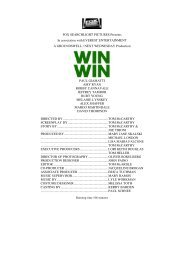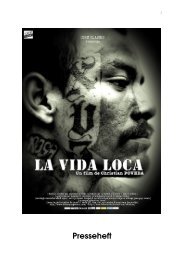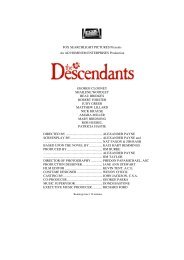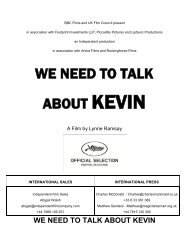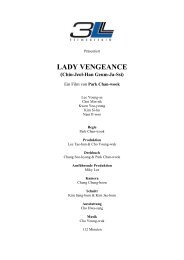TAKE THIS WALTZ - Mongrel Media
TAKE THIS WALTZ - Mongrel Media
TAKE THIS WALTZ - Mongrel Media
Create successful ePaper yourself
Turn your PDF publications into a flip-book with our unique Google optimized e-Paper software.
Light and heat coming into Margot’s home and life is a metaphor for what takes place<br />
throughout the story and Montpellier strove to duplicate the poetry of the screenplay on the<br />
canvas of his cinematography. The backlighting of Lou during ‘the Storm’ scene reflects the<br />
emotion of what is happening to Lou at that moment. “All you need is a clear idea to start and<br />
for me, for the production designers, for costume design, for all of us, it is the dramatic point of<br />
view from which we all work. Story informed everything.”<br />
It was story, specifically the “Storm” scene which made Polley and Montpellier decide to shot<br />
the film digitally. This allowed them to let the camera roll for over two hours continuously.<br />
There’s an emotional response to images you get when you are able to film them at certain<br />
times of the day. Shooting at magic hour (a misnomer because this is the last 15 minutes of<br />
sunlight in a day, as well as the first 15 minutes in early morning) was something Polley wrote<br />
into the script. As the sun set on Margot’s marriage, it also rose on the potentially new<br />
relationship she had with Daniel. “Neither of these scenes would have had the same significance<br />
if they were shot at high noon,” commented Montpellier.<br />
“For the hero house, where Lou and Margo live, the colours are slightly off prime because I<br />
didn’t see Sarah’s ‘bowl of fruit’ as being fresh, but rather sticky and over ripe,” remarked<br />
Production Designer Matthew Davies. “I wanted a sense of heat building up in the house,<br />
slightly oppressive, with a treacley, beautiful amber light filtering through the windows. This is in<br />
direct contrast to Daniel’s apartment which is bright white with high key, primary colours.”<br />
As envisioned by Polley, the hero house in Toronto’s Little Portugal (which is the scripted<br />
neighbourhood) is a fine example of real estate as biography, embodying the spirit of Queen<br />
West: a liberal, independent middle class couple would have bought the place when the market<br />
took a momentary downturn and then began extensive renovations which dragged on.<br />
“Unfinished, like everything else in Lou and Margot’s life,” continued Davies. “So we see the<br />
uneven surfaces, exposed wiring and peeling plaster. Textured surfaces play light in an<br />
interesting way so we used grass wallpapers, a shiny, leather sofa, which has a sticky quality and<br />
the coffee table made from samples of linoleum. The colours are oranges, greens and a nicotinekhaki.”<br />
The interior walls of the house are a very saturated, hot, apricot colour and is further<br />
intensified by installing amber and lilac glass panels which pick up shafts of exterior light shining<br />
through into the house through patterned gobos, lace sheers and wicker blinds. And in every<br />
room are oscillating fans. The effect of heat is a result of layer upon layer upon layer of<br />
architectural detail.”<br />
Davies furnished the house with vintage pieces, re‐appropriated from other sources. The art on<br />
the living room wall, created specifically for the film, is a photographic triptych of seven graffiti<br />
artists (mostly kids from a city project) at one Toronto streetcar stop. This piece is made more<br />
significant as a result of the agenda of the new mayor of Toronto, Rob Ford, who had that<br />
particular wall painted over a few months after the film was completed. This is also the same<br />
streetcar stop in the scene where Daniel, with his rickshaw, passes by Margot.<br />
“To say Sarah is collaborative doesn’t do justice to her approach. Sarah is very multi‐layered and<br />
cultivates very healthy relationships with the crew, allowing everyone to feel like they are a part<br />
of the project, to invest themselves in it, and bring something exceptional of themselves to the<br />
film,” explained Davies.<br />
13



